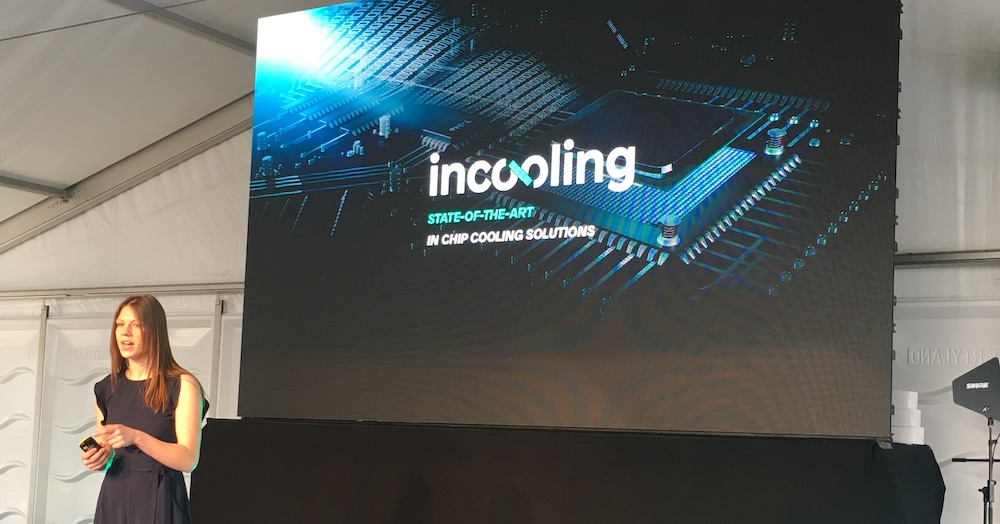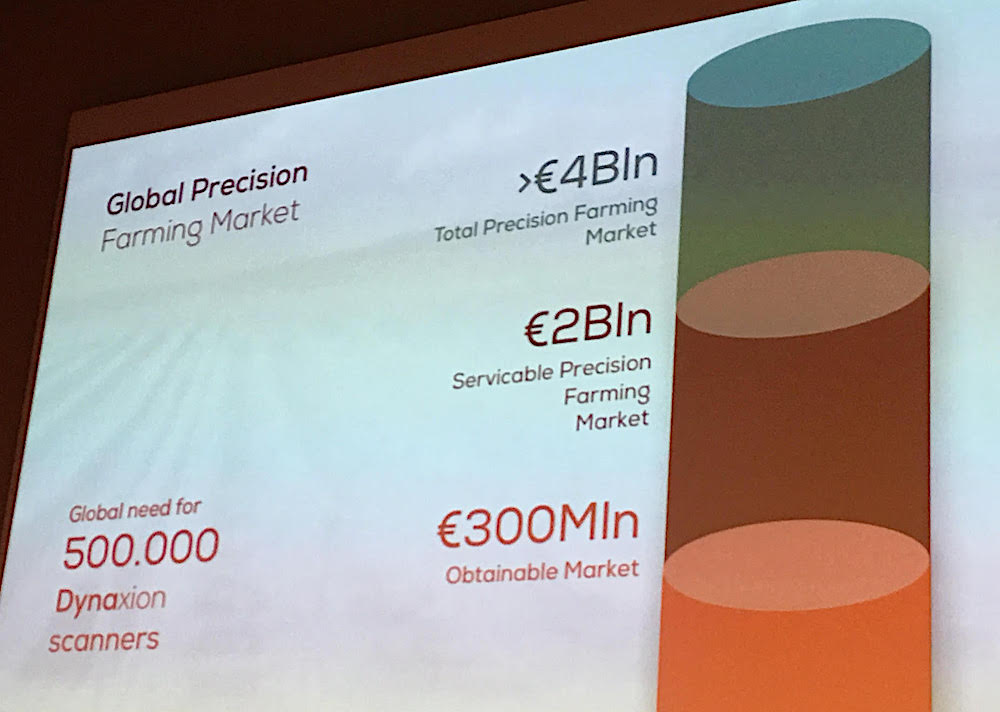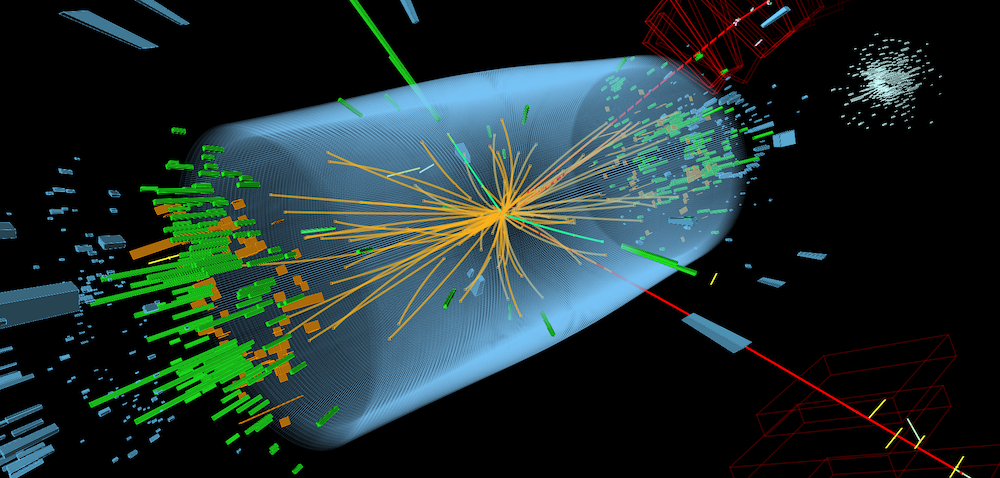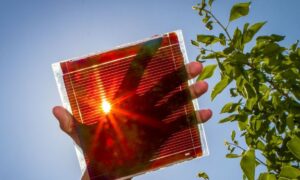You say you want a revolution? Try this one.
What happens when you turn the startup model on its head? What if startups start not with a vague idea, but with advanced technology from CERN. Yes, that CERN … the Swiss scientific research center that collides atoms and searches for God particles. And for fun, let’s say they have weeks, not years, to team up with complete strangers and figure it all out. What would be the result?
Glad you asked …..
At HighTechXL’s XL Day event, the answer was, “Four teams and five companies that have refined radical concepts on the way to making them into businesses.”
The invitation-only XL Day event at Philips auditorium on High Tech Campus Eindhoven got a sneak-peek at the technology that’s coming out of the Eindhoven-based deep tech accelerator’s agreement in early 2018 with Basel-based CERN and Dutch research agency Nikhef to bring their technology to the world. (See the related HighTechXL post here.) Those technologies are CO2 cooling, a small linear proton accelerator and a structured laser.
HighTechXL’s CERN effort started with a July Hackathon that attracted more than 100 people. Those groups then coalesced into teams in September though lineups weren’t final until a few days ago.
“The last couple of months, we’ve been working our asses off to make this possible,” including at least one pivot and multiple team resets, said Guus Frericks, HighTechXL co-founder and CEO. Notable in the CERN project is team diversity, Frericks said: “We’re super proud to have seen so many female founders telling exceptional stories.”
Let’s look at the results:
DYNAXION
HighTechXL trainee Emma Palmen gave the Dynaxion pitch, which includes using CERN’s small quadrupole linear particle accelerator/collider. The goal is to create a better way to scan everything from the 100 billion packages projected to be shipped worldwide by 2020 to luggage at the airport.
Palmen cited data that current scanning technology fails to detect one in five prohibited items. In a show-stopping moment, Palmen showed the X-ray of a box filled with what appeared to be drugs. When she opened the box, it turned out to be filled with Schudde Buikjes, small Dutch cookies.
Her point was that conventional scanning technology including advanced CT scanners can’t tell the difference between Ecstacy and candy, baby powder and heroin. And anytime there’s uncertainty, it takes an entire legal process to get permission to open and inspect the package. As e-commerce pushes the shipping volume ever higher, new technology is needed, Palmen said. And that’s Dynaxion.
The Dynaxion scanner utilizes the extremely short wavelength – 10 to the 14th nanometer – of the CERN fast proton beam proton accelerator for far greater resolution than X-rays, and that’s important in finding dangerous and/or illegal substances. Dynaxion’s scanner concept is also safer for employees than current technology, and that satisfies CERN’s technology transfer requirements for social accountability to stakeholders and the public, Palmen added.
“That’s why we believe Dynaxion contributes to a safer world,” she said.
The team is working with ASML and is in contact with parcel delivery firm DPDgroup, based in Aschaffenburg, Germany and UPS in the United States. The team is exploring airport security with Eindhoven-based logistics automation giant Vanderlande, part of Toyota Industries Corporation.
The Dynaxion details:
The market: $4 billion alone on parcel screening. Dynaxion projects selling the 3 million euro scanners as well as recurring payments for maintenance and upgrades.
What they need: The team is raising 500,000 euros through government subsidies. They need to hire an additional physicist and a business development person.
The goal: The team wants to finalize the first prototype by the end of 2020, then conduct a pilot project with a customer.
The Dynaxion Team includes:
Cor Datema, Netherlands
Bert Verstraeten, Netherlands
Fabiola Jimenez, Spain
Joep Staps, Netherlands
Emma Palmen, Netherlands
MICROSPOT COMMUNICATIONS
Everyone loves to communicate, and that’s a problem as well as an opportunity.
HighTechXL acceleration manager Luis Oliveira gave the MicroSpot Communications pitch, noting that the exploding demand for communications capacity threatens to overwhelm conventional telecom infrastructure.
By 2026, the amount of data transferred by cellphones is expected to be 10 times higher than today. About 96 percent of world population doesn’t have access to high-speed internet. SpaceX, Google and Facebook have different concepts, including satellites related to providing connectivity to the entire world.
“The existing telecommunications infrastructure is simply not enough. We’re going to need a lot more cell towers,” Oliveira said. Those cell towers will connect via microwave and/or fibre optics, but both have issues including build-out costs.
The telecom industry is looking for alternatives including free-space optics. Which is where MicroSpot comes in. MicroSpot uses CERN’s structured laser beam technology which Oliveira called “fibre optics through the air.” MicroSpot’s technology covers a greater distance and can supply eight times more bandwidth than the best of the conventional telecom technology, he said.
If you’re thinking a lot of companies will be interested, you’d be right. Chinese wireless and telecommunications giant Huawei “wanted to connect us to their investment arm,” Oliveira said. But his team’s strategy is first to partner with an engineering firm, then sell products to telecoms.
The MicroSpot details:
Needs: 2.5 million euros to build its prototype
The potential market: 33.7 billion euros
MicroSpot’s piece of the action: 260 million euros in projected revenue by 2024
Potential clients/partners. MicroSpot is talking with executives at Huawei, Vodafone, KPN and other telecommunications companies.
The Plan: The MicroSpot teams wants to have its first commercial deployment by Q1 of 2019 and a market launch by Q3 next year.
The MicroSpot Team includes:
Guus Frericks, Netherlands
Jeroen Aerts, Netherlands
Edzard Janssens, Netherlands
John Reid, United Kingdom
Guido van Katweijk, Netherlands
Martijn Boerkamp, Netherlands
Luis Oliveira, Portugal
Advisors
Eddy Allefs from NTS Group, Netherlands
Jeroen Aerts from ASLM, Netherlands
Betsy Lindsey, United States

INCOOLING
HightechXL trainee Helena Samodurova gave the pitch for incooling, which uses CERN’s CO2 cooling technology.
Digital giants such as Facebook, Google and Apple are creating vast amounts of data they need to process ” and they need to process fast,” Samodurova said. “Why? Because we users expect our computers, phones and tablets to be way faster than the year before.”
So far, the semiconductor industry has met those expectations, but Gordon Moore’s prediction that chip memory would double every 18 months, with prices cut in half, is hitting the wall, she said. To cope with consumer expectations, chip makers have come up with all sorts of new approaches to solving the problems of the increased heat that comes with increased power and energy waste.
At least one company, NVIDIA, has come up with a “super-server” that has the power of 300 servers in one box. “Believe me, it’s fast, but that comes at a price because half the energy it uses goes to waste,” Samodurova said. NVIDIA has created a complicated system to cool the processor. IBM also created a low-pressure system to cool their high-performance chips.
With CERN, incooling has developed an on-chip technology on the way to an in-chip cooling solution that stacks chips with cooling in between, tech that uses high-pressure (700 bars) CO2 pumped through nano-tubes the width of a hair. That allows increased clock speed as heat capture increases thermal stability by 10 times.
“Ladies and gentlemen, that’s what we call here ‘deep tech,'” Samodurova said.
The incooling details:
The potential market: $284 million market projected to grow to $2 billion in just 4 years
Business plan: Target large companies such as IBM. The team projects having its first product by 2020, with in-chip cooling by 2021.
Needs: The incooling team needs to raise 500,000 euros in 2019, and $5 million to launch in 2020, including capital to expand the team.
Partners: ASML, CERN, NTS and NIKHEF
incooling team members include:
Rudie Verweij, Netherlands
Helena Samodurova, Latvia
Karen Huaracha Magaña, Mexico
Ramon Haken, Netherlands
Mahmoud El Abassi, Lebanon
Pieter Smorenburg, Netherlands
Guus Frericks, Netherlands
MICROSPOT METROLOGY
HighTechXL acceleration manager Edzard Janssens pitched for the MicroSpot Metrology team, and his presentation focused on the accuracy critical to chip making.
ASML, which makes the photolithography machines that make the semiconductor industry possible, invested 100 million in their metrology systems in 2018 alone, Janssens said. The standard technology to assure accurate circuitry etched on chips now is laser interferometers. But dust particles in the optical light path can disrupt the measurement accuracy crucial to aligning of silicon wafers in the photolithography imprinting process.
MicroSpot Metrology’s new structured laser beam interferometers use CERN technology to create a device that’s more accurate and reliable than current Gaussian Beam technology. Even better, the CERN technology allows the laser beam to reconstruct itself should it be partially blocked. “Dust or any other kind of contamination will no longer be an issue,” Janssens said.
Physicist John Reid of the MicroSpot team received the award for Most Exceptional Contributor.
The MicroSpot Metrology details:
The goal: To have the first functional prototype complete by 2020. After testing, MicroSpot Metrology will go to market in 2023
They need: MicroSpot Metrology needs to raise 1 million euros
The plan: To test the tech and business plan during 2019.
Working with: NTS on development with the goal of having ASML as first customer.
The MicroSpot Team includes:
Guus Frericks, Netherlands
Jeroen Aerts, Netherlands
Edzard Janssens, Netherlands
John Reid, United Kingdom
Guido van Katweijk, Netherlands
Martijn Boerkamp, Netherlands
Luis Oliveira, Portugal

DYNAXION AGRO
A few weeks ago, this team didn’t exist. But after some major reshuffling and exits, Dynaxion Agro came through with their next-gen soil scanning concept. ABN AMRO executive Ingrid Romeijn gave the pitch for Dynaxion Agro, which is using CERN technology to provide better soil analysis in order to increase food production without claiming new land.
“We need to double food production as world population grows,” Romeijn said. Too often, increased food production leads to deforestation, with farmers destroying 20 soccer fields of forest every minute, Romeijn said. Over-fertilization of soil is also an issue.
Her team’s solution is using CERN’s small quadrupole linear particle accelerator/collider to create drones that roam farms generating incredibly accurate soil quality analysis. Soil quality is the no. 1 element in crop yields. Improve the soil and you get more food, Romeijn said. But conventional soil sampling is labor intensive and not scaleable. Dynaxion Agro’s methods are far faster, more accurate and scalable than satellite imaging and conventional soil sampling.
“Let’s secure a wold that provides for all,” Romeijn said.
For their quick turnaround, Romeijn and her team received the “Most Courageous Pivot” award at XL Day.
The Dynaxion Agro details:
Size of the global precision farming market: 4 billion euros
Dynaxion Agro’s projected attainable market: 300 billion euros
Business model: Each unit sells for 3 million, with a projected 100,000 euros in annual service and maintenance fees and 250,000 euros in system and database upgrades.
Where Dynaxion Agro is: The team is currently in the validation phase, working with a university.
What they need: 500,000 euros in initial funding.
First prototype: 2020, commercial launch 2022.
The Dynaxion Agro Team includes:
Ingrid Romeij, Netherlands
Simon van Gorp, Netherlands
Eric Broekhuizen, Netherlands
Mirjam Bel, Netherlands
ABOUT THE GROUPS INVOLVED IN THE CERN TECHNOLOGY KNOWLEDGE TRANSFER EFFORT
CERN:
Based in Geneva and funded by 22 member nations, CERN administers a number of research centers and projects, including two linear accelerators and several colliders, including the Large Hadron Collider. But it’s in the medical technology domain that physics research, including the work done at CERN, has had a major impact, with magnetic resonance imaging, positron emission tomography and other technologies. “People think we’re mostly physicists, but the truth is, CERN is the biggest machine in the world,” said Bilton. “Most of the people who work there are engineers and technicians we need to keep it running.”
In 2012, CERN adopted CERN Easy Access, a technology transfer initiative to make it easier for businesses and entrepreneurs to access intellectual property generated by its researchers.
About NIKHEF:
The National Institute for Subatomic Physics, or Nikhef, is based in Amsterdam. Nikhef is the Dutch organization that carries out research into the elementary building blocks of our universe, their mutual forces and the structure of space and time. Nikhef partners with CERN on the Nikhef-CERN Business Incubation Center.
About HIGHTECHXL:
HighTechXL is the Netherlands’ premier high-tech accelerator, focusing mostly on hardware since its inception in 2014. HighTechXL is an initiative of the Eindhoven Startup Alliance with ASML, Philips, NTS group, High Tech Campus Eindhoven, ABN AMRO Bank, Brabantse Ontwikkelings Maatschappij (BOM), EY and HVG as its members.
About ASML:
ASLM, based in Eindhoven, makes the machines that make the semiconductor – and the digital age – work. ASML is the main supplier of machines the semiconductor industry uses to burn microcircuitry onto microchips.














